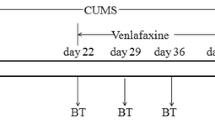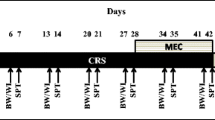Abstract
Depression may relate to neurocognitive impairment that results from alteration of N-methyl-d-aspartate receptor (NMDAR) levels. Venlafaxine and escitalopram are two drugs commonly used to treat depression. The drugs may affect expression of NMDARs, which mediate learning and memory formation. The aim of the study was to examine whether the effects of venlafaxine and escitalopram treatments are associated with NMDARs in a rat model of depression. Forty male Wistar albino rats were randomly divided into four groups (n = 10) as follows: control group, chronic mild stress group (CMS), venlafaxine (20 mg/kg body weight per day) + CMS, and escitalopram (10 mg/kg body weight per day) + CMS. After induction of depression, a decrease in the concentration of NR2B was observed; venlafaxine treatment prevented the reduction of NR2B expression. Escitalopram treatment did not effect the reduced levels of NR2B resulting from depression. There was no significant difference in NR2A concentration among groups. The present data support the notion that venlafaxine plays a role in maintaining NR2B receptor in experimental depression. It may be possible that treatment with escitalopram has no effect on NMDARs in experimental depression.


Similar content being viewed by others
References
Boyer PA, Skolnick P, Fossom LH (1998) Chronic administration of imipramine and citalopram alters the expression of NMDA receptor subunit mRNAs in mouse brain. A quantitative in situ hybridization study. J Mol Neurosci 10:219–233
Bremner JD, Vythilingam M, Vermetten E, Charney DS (2007) Charney effects of antidepressant treatment on neural correlates of emotional and neutral declarative verbal memory in depression. J Affect Disord 101:99–111
David DJ, Samuels BA, Rainer Q, Wang JW, Marsteller D, Mendez I, Drew M, Craig DA, Guiard BP, Guilloux JP, Artymyshyn RP, Gardier AM, Gerald C, Antonijevic IA, Leonardo ED, Hen R (2009) Neurogenesis-dependent and -independent effects of fluoxetine in an animal model of anxiety/depression. Neuron 62(4):479–493
Davidson RJ, Putnam KM, Larson CL (2000) Dysfunction in the neural circuitry of emotion regulation—a possible prelude to violence. Science 289:591–594
Dong J, Min S, Wei K, Li P, Cao J, Li Y (2010) Effects of electroconvulsive therapy and propofol on spatial memory and glutamatergic system in hippocampus of depressed rats. J ECT 26:126–130
Eren I, Naziroglu M, Demirdas A (2007a) Protective effects of lamotrigine, aripiprazole and escitalopram on depression-induced oxidative stress in rat brain. Neurochem Res 32:1188–1195
Eren I, Naziroğlu M, Demirdaş A, Celik O, Uğuz AC, Altunbaşak A, Ozmen I, Uz E (2007b) Venlafaxine modulates depression-induced oxidative stress in brain and medulla of rat. Neurochem Res 32:497–505
Eriksson TM, Delagrange P, Spedding M, Popoli M, Mathé AA, Ogren SO, Svenningsson P (2011) Emotional memory impairments in a genetic rat model of depression: involvement of 5-HT/MEK/Arc signaling in restoration. Mol Psychiatry (in press)
Fairhall SL, Sharma S, Magnusson J, Murphy B (2010) Memory related dysregulation of hippocampal function in major depressive disorder. Biol Psychol 85(3):499–503
Feyissa AM, Chandran A, Stockmeier CA, Karolewicz B (2009) Reduced levels of NR2A and NR2B subunits of NMDA receptor and PSD-95 in the prefrontal cortex in major depression. Prog Neuropsychopharmacol Biol Psychiatry 1:70–75
Fink K, Göthert M, Molderings G, Schlicker E (1989) N-methyl-d-aspartate (NMDA) receptor-mediated stimulation of noradrenaline release, but not release of other neurotransmitters, in the rat brain cortex: receptor location, characterization and desensitization. Naunyn Schmiedebergs Arch Pharmacol 339:514–521
García-Cabeza I, de Blas MM, Epifanio MM, de Chávez MG (2011) Cognitive deterioration after venlafaxine overdose. J Emerg Med 40:103–106
Gladding CM, Raymond LA (2011) Mechanisms underlying NMDA receptor synaptic/extrasynaptic distribution and function. Mol Cell Neurosci (in press)
Goretti B, Portaccio E, Zipoli V, Hakiki B, Siracusa G, Sorbi S, Amato MP (2010) Impact of cognitive impairment on coping strategies in multiple sclerosis. Clin Neurol Neurosurg 112:127–130
Grippo AJ, Beltz TG, Johnson AK (2003) Behavioral and cardiovascular changes in the chronic mild stress model of depression. Physiol Behav 78:703–710
Hansson AC, Rimondini R, Heilig M, Mathé AA, Sommer WH (2011) Dissociation of antidepressant-like activity of escitalopram and nortriptyline on behaviour and hippocampal BDNF expression in female rats. J Psychopharmacol (in press)
Karolewicz B, Stockmeier CA, Ordway GA (2005) Clinical research elevated levels of the NR2C subunit of the NMDA receptor in the locus coeruleus in depression. Neuropsychopharmacology 30:1557–1567
Katsuki H, Izumi Y, Zorumski CF (1997) Noradrenergic regulation of synaptic plasticity in the hippocampal CA1 region. J Neurophysiol 77:3013–3020
Kepe V, Barrio JR, Huang SC, Ercoli L, Siddarth P, Shoghi-Jadid K, Cole GM, Satyamurthy N, Cummings JL, Small GW, Phelps ME (2006) Serotonin 1A receptors in the living brain of Alzheimer’s disease patients. Proc Natl Acad Sci USA 103:702–707
Klein N, Sacher J, Geiss-Granadia T, Attarbaschi T, Mossaheb N, Lanzenberger R, Pötzi C, Holik A, Spindelegger C, Asenbaum S, Dudczak R, Tauscher J, Kasper S (2006) In vivo imaging of serotonin transporter occupancy by means of SPECT and [123I] ADAM in healthy subjects administered different doses of escitalopram or citalopram. Psychopharmacology (Berlin) 188:263–272
Kojima T, Matsumoto M, Togashi H, Tachibana K, Kemmotsu O, Yoshioka M (2003) Fluvoxamine suppresses the long-term potentiation in the hippocampal CA1 field of anesthetized rats: an effect mediated via 5-HT1A receptors. Brain Res 959:165–168
Laemmli UK (1970) Cleavage of structural proteins during the assembly of the head of bacteriophage T4. Nature 227(5259):680–685
Leonard BE (2000) Evidence for a biochemical lesion in depression. J Clin Psychiatry 61:12–17
Malberg JE, Eisch AJ, Nestler EJ, Duman RS (2000) Chronic antidepressant treatment increases neurogenesis in adult rat hippocampus. J Neurosci 20:9104–9110
Monyer H, Sprengel R, Schoepfer R, Herb A, Higuchi M, Lomeli H, Burnashev N, Sakmann B, Seeburg PH (1992) Heteromeric NMDA receptors: molecular and functional distinction of subtypes. Science 256(5060):1217–1221
Nelson CJ, Jordan WP, Bohan RT (1997) Daily fluoxetine administration impairs avoidance learning in the rat without altering sensory thresholds. Prog Neuro-Psychophamacol Biol Psychiatry 21:1043–1057
Nestler EJ, Barrot M, DiLeone RJ, Eisch AJ, Gold SJ, Monteggia LM (2002) Neurobiology of depression. Neuron 34(1):13–25
Nowakowska E, Kus K, Bobkiewicz-Kozłowska T, Hertmanowska H (2002) Role of Neuropeptides in antidepressant and memory improving effects of venlafaxine. Pol J Pharmacol 54:605–613
Rauner C, Köhr G (2011) Triheteromeric NR1/NR2A/NR2B receptors constitute the major N-methyl-d-aspartate receptor population in adult hippocampal synapses. J Biol Chem 286:7558–7566
Tachibana K, Matsumoto M, Togashi H, Kojima T, Morimoto Y, Kemmotsu O, Yoshioka M (2004) Milnacipran, a serotonin and noradrenaline reuptake inhibitor, suppresses long-term potentiation in the rat hippocampal CA1 field via 5-HT1A receptors and a1-adrenoceptors. Neuroscience Letters 357(2):91–94
Tokita K, Yamaji T, Hashimoto K (2011) Roles of glutamate signaling in preclinical and/or mechanistic models of depression. Pharmacol Biochem Behav
Wade A, Michael Lemming O, Bang Hedegaard K (2002) Escitalopram 10 mg/day is effective and well tolerated in a placebo-controlled study in depression in primary care. Int Clin Psychopharmacol 17:95–102
Wikell C, Apelqvist G, Hjorth S, Kullingsjö J, Bergqvist PB, Bengtsson F (2002) Effects on drug disposition, brain monoamines and behavior after chronic treatment with the antidepressant venlafaxine in rats with experimental hepatic encephalopathy. Eur Neuropsychopharmacol 12:327–336
Willner P, Muscat R, Papp M (1992) Chronic mild stress-induced anhedonia: a realistic animal model of depression. Neurosci Biobehav Rev 16:525–534
Wrzosek A, Obara I, Wordliczek J, Przewlocka B (2009) Efficacy of tramadol in combination with doxepin or venlafaxine in inhibition of nociceptive process in the rat model of neuropathic pain: an isobolographic analysis. J Physiol Pharmacol 60:71–78
Yuen EY, Jiang Q, Chen P, Gu Z, Feng J, Yan Z (2005) Serotonin 5-HT1A receptors regulate NMDA receptor channels through a microtubule-dependent mechanism. J Neurosci 25:5488–5501
Zarate C Jr, Machado-Vieira R, Henter I, Ibrahim L, Diazgranados N, Salvadore G (2010) Glutamatergic modulators: the future of treating mood disorders? Harv Rev Psychiatry 18:293–303
Zhong P, Liu W, Gu Z, Yan Z (2008) Serotonin facilitates long-term depression induction in prefrontal cortex via p38 MAPK/Rab5-mediated enhancement of AMPA receptor internalization. J Physiol 586(pt 18):4465–4479
Author information
Authors and Affiliations
Corresponding author
Rights and permissions
About this article
Cite this article
Yilmaz, N., Demirdas, A., Yilmaz, M. et al. Effects of Venlafaxine and Escitalopram Treatments on NMDA Receptors in the Rat Depression Model. J Membrane Biol 242, 145–151 (2011). https://doi.org/10.1007/s00232-011-9385-3
Received:
Accepted:
Published:
Issue Date:
DOI: https://doi.org/10.1007/s00232-011-9385-3




